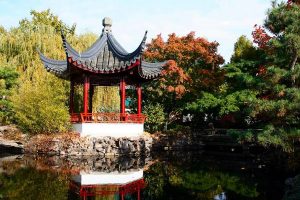A guided tour of Nine Classical Gardens in China
In addition to the Beijing Summer Palace and the Chengde Mountain Resort in Hebei Province, a complete tour of the Four Greatest Classical Gardens in China must include the Humble Administrator’s Garden and the Lingering Garden in Suzhou, the capital of Chinese gardens. Together with seven other private gardens, the nine unique masterpieces make the list of the UNESCO World Heritage Site.
Unlike the imperial gardens in Beijing and Chengde, Suzhou gardens are mostly private gardens. These gardens are part of the impressive residential complexes formerly owned by noble families, wealthy merchants and senior civil servants of the historic city. The cultured city dwellers, for over 1000 years, found a refuge in the refined miniature of nature without leaving their homes.
Combining garden landscaping, Chinese painting and poetry in the design and architecture of their works, the great garden designers of antiquity constructed a three dimensional Chinese painting with poetic elegance for enjoying the beauty, serenity and spirituality of nature. The nine Suzhou classical gardens are the best representations of Chinese cultural and artistic soul in the Yangtze River Delta Region.
The Humble Administrator’s Garden
It is the oldest garden among the Four Greatest Classical Gardens in China. Built in the Ming Dynasty in 1509, it is also the biggest and most well-known garden in Suzhou. With a lake covering one-fifth of the garden area, the Humble Administrator’s Garden highlights its thematic attraction of water in the central part of the garden.
The Lingering Garden
It is one of the Four Greatest Classical Gardens in China. Built in the Ming Dynasty in 1593, the Lingering Garden is divided into four parts, namely the central, east, west and north. The central part, centers on man-made mountains and a lake, is the most scenic area of the garden.
The Surging Wave Pavilion (also known as the Canglang Pavilion)
Built in the Northern Song Dynasty between 1041 and 1048, it is the oldest garden in Suzhou. The design of having the waterscapes outside the garden is unique among all Suzhou gardens. The man-made mountains and scenic forest create the impression of walking through a primitive mountain forest inside the Surging Wave Pavilion.
The Master-of-Nets Garden
Built in the Southern Song Dynasty between 1174 and 1189, it is the smallest garden in Suzhou. The thematic attraction is the architecture and waterscapes. The Master-of-Nets Garden exemplifies the classic blending of landscape garden with living quarters.
The Mountain Villa with Embracing Beauty
Built in the Qing Dynasty in 1884, the Mountain Villa with Embracing Beauty is famous for its limestone mountain. The seven-meter peak is an outstanding sight in the garden. Buildings like the front and rear halls are constructed opposite to the mountain and surrounded by pines, cypresses, crape myrtle and magnolia conspicus.
The Lion Forest Garden
Built in the Yuan Dynasty in 1341, it is most famous for its clusters of man-made mountains which are the biggest of its kind among Suzhou gardens. There are nine mountain paths and twenty-one caves in the garden. Rocks with various shapes and sizes, many of which resembling lions, are another unique attraction in the Lion Forest Garden.
The Garden of Cultivation
Built in the Ming Dynasty in 1541, its water pond, taking up one-fifth of the Garden of Cultivation, is flanked on the south by mountain scene and on the north by the grand hall and the Water Pavilion of Longevity, the biggest waterside pavilion in Suzhou.
The Couple’s Garden
Built in the Qing Dynasty in 1874, the garden is surrounded by three canals and made up of two parts on either side of the housing complex. The eastern and western gardens are like a couple and hence the name of the garden. Main attraction lies in the eastern garden, featuring a man-made mountain rising from a pond with a series of pavilions, towers and terraces around it.
The Retreat and Reflection Garden
Built in the Qing Dynasty in 1885, it is located in Tongli, a small water town on the outskirt of Suzhou. Visit to the garden is included in the tour of the picturesque town. The Retreat and Reflection Garden comprises a housing complex and a garden connected by a spacious garden court. A boat-like pavilion, a typical Tongli architectural style, acts as a reception area near the entrance of the garden court. The whole design gives the impression of gardens within the garden.
Getting to Suzhou
Suzhou is well connected by trains and coaches with Shanghai and Nanjing. There is a bus going directly from the Shanghai airport to Suzhou. Getting around the capital of Chinese gardens is also easy by means of tourist and public buses.





